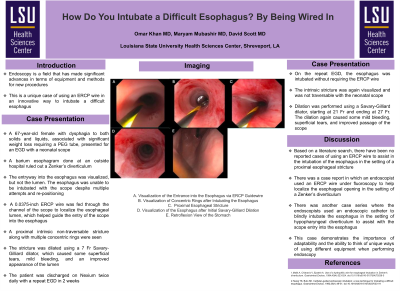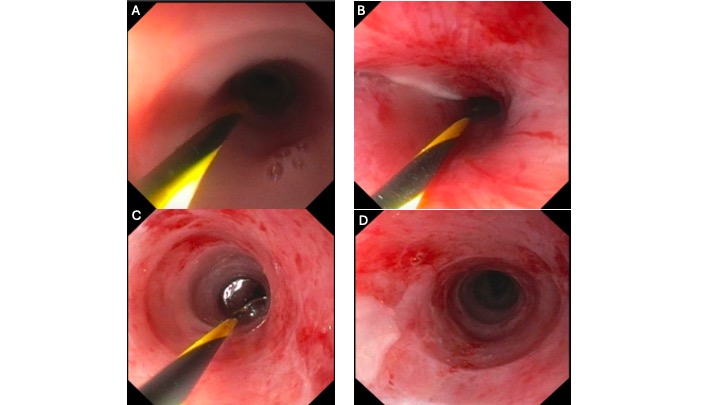Sunday Poster Session
Category: General Endoscopy
P0688 - How Do You Intubate a Difficult Esophagus? By Being Wired in
Sunday, October 27, 2024
3:30 PM - 7:00 PM ET
Location: Exhibit Hall E

Has Audio
- OK
Omar Khan, MD
LSU Health
Shreveport, LA
Presenting Author(s)
Omar Khan, MD, Maryam Mubashir, MD, David Scott, MD
LSU Health, Shreveport, LA
Introduction: Endoscopy is a field that has made significant advances in terms of equipment and methods for new procedures. This is a unique case of using an ERCP wire in an innovative way to intubate a difficult esophagus.
Case Description/Methods: A 67-year-old female with dysphagia to both solids and liquids, associated with significant weight loss requiring a PEG tube, presented for an EGD with a neonatal scope. The patient had a barium esophagram done at an outside hospital that ruled out a Zenker’s diverticulum. Upon starting the procedure, the entryway into the esophagus was visualized, but not the lumen. The esophagus was unable to be intubated with the scope despite multiple attempts and re-positioning. The decision was made to feed a 0.0375-inch ERCP wire through the channel of the neonatal scope to localize the esophageal lumen. This helped guide the entry of the scope into the esophagus. A proximal intrinsic stricture along with multiple concentric rings were seen through the entire esophagus. The remainder of the exam showed a normal stomach and duodenum. Afterwards, the stricture was dilated using a 7 Fr Savary-Giliard dilator, which caused some superficial tears, mild bleeding, and an improved appearance of the lumen. The patient was discharged on Nexium BID with a repeat EGD in 2 weeks. On the repeat EGD, the esophagus was intubated without requiring the ERCP wire, but the intrinsic stricture was again visualized. This was not traversable with the neonatal scope, so dilation was performed again using a Savary-Giliard dilator, starting at 21 Fr and ending at 27 Fr. The dilation again caused some mild bleeding, superficial tears, and improved passage of the scope.
Discussion: Based on a literature search, there have been no reported cases of using an ERCP wire to assist in the intubation of the esophagus in the setting of a proximal esophageal stricture. There was a case report in which an endoscopist used an ERCP wire under fluoroscopy to help localize the esophageal opening in the setting of a Zenker’s diverticulum. There was another case series where the endoscopists used an endoscopic catheter to blindly intubate the esophagus in the setting of hypopharyngeal diverticulum to assist with the scope entry into the esophagus. This case demonstrates the importance of adaptability and the ability to think of unique ways of using different equipment when performing endoscopy.

Disclosures:
Omar Khan, MD, Maryam Mubashir, MD, David Scott, MD. P0688 - How Do You Intubate a Difficult Esophagus? By Being Wired in, ACG 2024 Annual Scientific Meeting Abstracts. Philadelphia, PA: American College of Gastroenterology.
LSU Health, Shreveport, LA
Introduction: Endoscopy is a field that has made significant advances in terms of equipment and methods for new procedures. This is a unique case of using an ERCP wire in an innovative way to intubate a difficult esophagus.
Case Description/Methods: A 67-year-old female with dysphagia to both solids and liquids, associated with significant weight loss requiring a PEG tube, presented for an EGD with a neonatal scope. The patient had a barium esophagram done at an outside hospital that ruled out a Zenker’s diverticulum. Upon starting the procedure, the entryway into the esophagus was visualized, but not the lumen. The esophagus was unable to be intubated with the scope despite multiple attempts and re-positioning. The decision was made to feed a 0.0375-inch ERCP wire through the channel of the neonatal scope to localize the esophageal lumen. This helped guide the entry of the scope into the esophagus. A proximal intrinsic stricture along with multiple concentric rings were seen through the entire esophagus. The remainder of the exam showed a normal stomach and duodenum. Afterwards, the stricture was dilated using a 7 Fr Savary-Giliard dilator, which caused some superficial tears, mild bleeding, and an improved appearance of the lumen. The patient was discharged on Nexium BID with a repeat EGD in 2 weeks. On the repeat EGD, the esophagus was intubated without requiring the ERCP wire, but the intrinsic stricture was again visualized. This was not traversable with the neonatal scope, so dilation was performed again using a Savary-Giliard dilator, starting at 21 Fr and ending at 27 Fr. The dilation again caused some mild bleeding, superficial tears, and improved passage of the scope.
Discussion: Based on a literature search, there have been no reported cases of using an ERCP wire to assist in the intubation of the esophagus in the setting of a proximal esophageal stricture. There was a case report in which an endoscopist used an ERCP wire under fluoroscopy to help localize the esophageal opening in the setting of a Zenker’s diverticulum. There was another case series where the endoscopists used an endoscopic catheter to blindly intubate the esophagus in the setting of hypopharyngeal diverticulum to assist with the scope entry into the esophagus. This case demonstrates the importance of adaptability and the ability to think of unique ways of using different equipment when performing endoscopy.

Figure: A: Intubation into the Esophagus
B: Upper Esophageal Stricture
C: Concentric Rings
D: Esophagus after Dilation with Savary-Giliard Dilator
B: Upper Esophageal Stricture
C: Concentric Rings
D: Esophagus after Dilation with Savary-Giliard Dilator
Disclosures:
Omar Khan indicated no relevant financial relationships.
Maryam Mubashir indicated no relevant financial relationships.
David Scott indicated no relevant financial relationships.
Omar Khan, MD, Maryam Mubashir, MD, David Scott, MD. P0688 - How Do You Intubate a Difficult Esophagus? By Being Wired in, ACG 2024 Annual Scientific Meeting Abstracts. Philadelphia, PA: American College of Gastroenterology.
